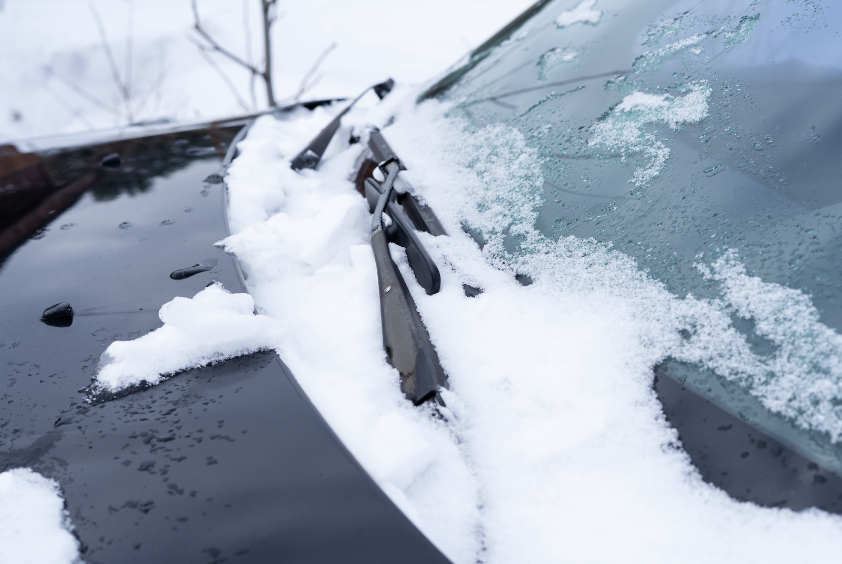
How To Winterize Your Vehicle
- Vehicle Maintenance
- PEAK
- December 27, 2023
Colder weather is upon us. Prepare your car for winter to protect yourself & prolong the lifespan of your vehicle. Learn vital steps to winterizing your vehicle.
Winter has made its annual appearance, bringing shorter days, frigid temperatures, ice-covered cars, and hazardous driving conditions.
For drivers, the dangers multiply in the winter, making it especially important to winterize your vehicle so that you’re ready to meet whatever challenges the season throws your way, whether you drive a two-door sedan or a full-sized pickup truck.


Here are seven essential steps to winterize your vehicle this year.
1. Schedule a Winter Weather Tune Up
Before the harsh winter weather puts you and your vehicle to the test, have your vehicle inspected and serviced by a qualified technician. A winter weather tune-up will assess your vehicle's winter readiness, including evaluating its battery, brakes, belts, hoses, spark plugs, wires, and cables.
2. Test Battery Performance
Cold weather weakens your car battery, so it takes extra energy to start your car, making it more likely that you will experience the inconvenience of a stalled vehicle.
Before you’re stuck with a car that won’t start, check your battery performance and replace it with a new one if needed. AAA recommends looking for key warning signs of a fading battery, including:
- A rotten egg smell can indicate an old or overcharged battery.
- A slowly starting engine or accessories failing to perform at peak capacity.
- A poorly illuminated vehicle caused by dim or flickering lights.
- A bulging or cracking battery case.
Car batteries typically last several years, but drivers should check their battery’s performance each winter to ensure that it’s ready to handle the season.
3. Install Durable Wiper Blades
Winter weather wreaks havoc on wiper blades. The sun’s rays will dry out the rubber, which can cause it to split or crack, while ice and snow can tear or otherwise damage the blades.
It’s a good idea to inspect your blades a few times a year. Regardless, you’ll want to replace your windshield wiper blades every year, at a minimum, if not every six months. In frigid climates, you may need to replace them as much as twice a year.
PEAK® SILICONE PLATINUM™ wiper blades are designed to keep you safe on the road year round. Engineered to last four times longer than average wipers, these beam wiper blades deliver complete visibility throughout every season.


4. Switch to Winter Tires
The US Department of Transportation reports that nearly one-quarter of all winter-related crashes occur on snowy, slushy, or icy pavement. An additional 15 percent happens during snowfall or sleet.
Tires are where the car meets the road, and winter tires can go a long way to ensure that snow, slush, and ice don’t disrupt this critical connection.
Most cars come with all-season tires designed to, as the name suggests, perform reasonably well in all conditions. However, as AAA’s John Paul explains, “An old rule that I still use is that all-season tires work about 60% to 70% as well as winter tires in four-to-five inches of snow. If you need to be out before the snowplows, or want the best traction for your vehicle, winter tires are the best option.”
With over 70 percent of US drivers in “snowy” regions (receiving more than 5 inches of average snowfall each year), switching to winter tires can be an important safety step for you and your passengers.
5. Add Cold-Weather Anti-freeze Windshield Wash
Most drivers don’t give their windshield wash a second thought. They grab a bottle of the blue stuff and fill their tank for another stretch of driving. You may not notice the difference until it's too late, as snow and ice accumulate, and visibility is dangerously impaired.
In the winter, stay safe with a high-quality, smear-free wash that doesn’t leave a film or smudges on your windshield and can perform in extreme temperatures. To achieve this, you can set a reminder to change your wash each season, or you can add a year-round solution designed to accommodate every season’s specific demands.
PEAK® All Season 0˚F Windshield Wash provides an advanced solution that delivers optimal spot-free cleaning in both summer and winter months, relying on a higher-than-average alcohol content to melt frost, snow, and light ice down to -30°F.
6. Check Your Headlights
While just a quarter of driving takes place at night, more than half of traffic accidents resulting in death take place after dark. The Federal Highway Administration reports that visibility is often to blame, which is especially true in the winter when driving conditions can be challenging to navigate.
Even at their best, traditional headlights with high beams can only provide about 500 feet of visibility, leaving less time to react to hazardous road conditions. According to Popular Mechanics, even minor problems, like misaligned lights, can “reduce reaction time to zero.”
In addition to checking your bulbs for dim or hazy lighting, flicking bulbs, inactive high beams, and directional fidelity, consider replacing your existing lights, especially if they are outdated or showing signs of fatigue.
PEAK’s premium high-performance halogen headlights feature a high-energy light pattern, increased output, and whiter light. This creates a brighter light that illuminates more of the road for better visibility and safer driving at night.
7. Account for RVs or Other Secondary Vehicles
While preparing your primary vehicles for winter, don’t forget to account for your RVs and other secondary vehicles. Unplug and turn off amenities, like water heaters, drain all low-point drains, empty water lines, and add antifreeze to drains and outside water intake valves.
Often, these vehicles require unique products that winterize their plumbing systems and storage applications. PEAK® RV and Marine Antifreeze is specifically formulated to winterize these vehicles, accounting for all kinds of potable water plumbing systems and other winter storage components.
Winterize Before Blustery Weather Derails Your Drive
Winterizing your vehicle goes beyond just boosting its performance in the cold — it's about keeping you safe and extending your vehicle’s life. Following these simple steps can help prevent inconvenient breakdowns, spare you hefty repair bills, and prioritize your safety.
For expert assistance and quality products that keep your vehicle in top condition, visit PEAKAuto.com We’re here to help you gear up for winter with industry leading products that can keep you safe this winter season.
